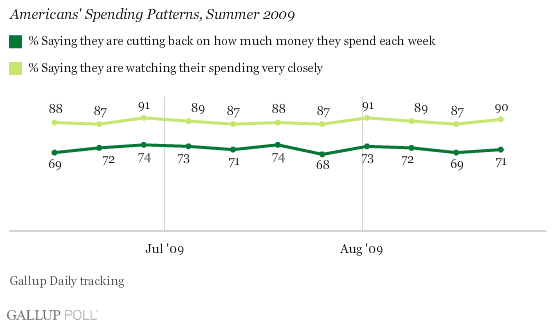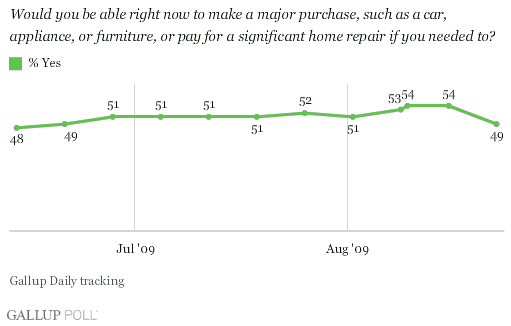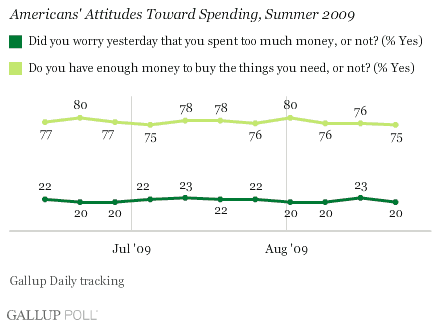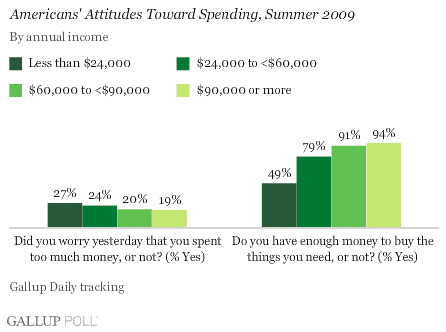PRINCETON, NJ -- Most Americans have consistently viewed themselves as financially cautious this summer, with about 9 out of 10 since early June saying they are watching their spending closely, and 7 in 10 saying they are cutting back on how much they spend each week. There has been little variation in these reported behaviors.

These data are part of a series of spending questions monitored as part of Gallup Daily tracking, and reported on an aggregated basis each week. Despite some evidence of positive change in overall consumer confidence this summer, the responses to these two spending questions echo the results of Gallup's monitor of actual consumer spending, which shows no sustained increase in self-reported spending throughout the summer months.
Solid majorities of Americans across all income categories report that they are watching their spending closely and are cutting back. Eight in 10 of those making $90,000 or more a year say they are watching their spending, and nearly two in three say they are cutting back on their spending -- nearly as high as the percentage of middle- and lower-income Americans doing the same.

Other Indicators
Several other Gallup Daily tracking indicators have shown little or no change throughout the summer in Americans' views of their personal financial situations or their attitudes about personal spending.
As one key example, about half of all Americans since early June have said they have enough money to make a major purchase or a significant home repair if necessary.

Unlike views on reducing and monitoring spending, however, the ability to make a major purchase (such as buying a car, an appliance, or furniture) or to pay for a significant home repair if necessary does increase with income. Three in four Americans making $90,000 or more a year say they could handle such an expenditure, compared with one in five of those making less than $24,000 a year.

Overall, these data suggest that simply having the financial wherewithal to make large purchases does not mean that one is going to spend with wild abandon.
Daily Worries
At the same time, Gallup's measures of attitudes toward spending continue to suggest that Americans may have adjusted -- at least to some degree -- to the idea of spending less and watching their spending closely.

About three-quarters of Americans say they have enough money to buy the things they need, and about 2 in 10 say they worried "yesterday" that they spent too much money. Thus, Americans seem to be adjusting well to what could be a period of "new normalcy" -- adjusting in the sense that Americans tend to get through the day without worrying about spending money even though they have cut back and are closely monitoring their spending.
Of course, the ability to buy what one needs is limited by income, with 94% of those making $90,000 or more a year saying they can buy what they need, compared to 49% of those making less than $24,000 a year. On the other hand, worry about spending is more equally distributed across incomes, with 27% of those making less than $24,000 saying they worried about what they spent yesterday -- not a great deal more than the 19% of those making $90,000 or more. These data on worrying suggest that many of those feeling more "cash-strapped" tend to be able to get through a typical day without worrying about their situations.

The Summer Spending New Normal
Over the summer, consumer spending has been generally consistent at levels far below those of a year ago. Upon further investigation, Gallup's tracking of attitudes toward spending suggests that this stability in spending over the last several months may reflect a new normal -- with Americans not only watching their spending closely and attempting to cut back, but at the same time appearing to have adjusted to this new behavior, with relatively few experiencing daily worry. This does not mean, of course, that Americans don't have pent-up desires to spend more when the economy recovers and/or when their incomes increase. It simply suggests that at the moment, Americans appear to be getting through their days with enough money to buy what they need, and also without constant worry.
Survey Methods
For Gallup Poll Daily tracking, Gallup interviews approximately 1,000 national adults, aged 18 and older, each day. The Gallup consumer perceptions of the economy and consumer spending results are based on random half-samples of approximately 500 national adults, aged 18 and older, each day. The Gallup job creation and job loss results are based on a random half sample of approximately 250 current full- and part-time employees each day. For the total samples of these surveys, one can say with 95% confidence that the maximum margin of sampling error is ±3 percentage points.
Interviews are conducted with respondents on land-line telephones (for respondents with a land-line telephone) and cellular phones (for respondents who are cell-phone only).
In addition to sampling error, question wording and practical difficulties in conducting surveys can introduce error or bias into the findings of public opinion polls.
